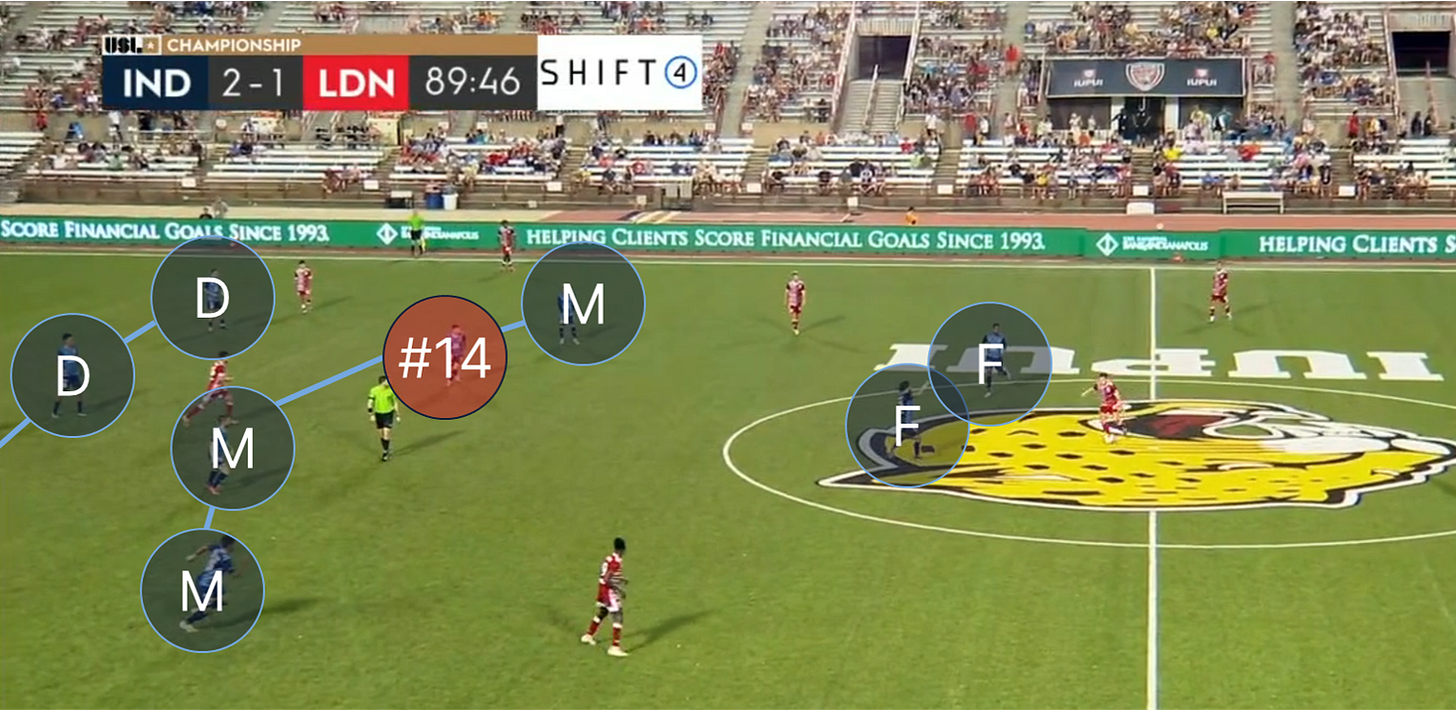As recently as August 5th, my playoff odds model gave Indy Eleven a meager 35% chance of reaching the postseason. That number is up to 81% thanks to a five-match unbeaten run for the Boys in Blue that includes four victories. Aodhan Quinn only has a single goal and a single assist in that stretch, but he’s been vital to Indy’s success.
Reaching this point hasn’t been a walk in the park for the Eleven. Mark Lowry and his front office recruited a veritable all-star team this offseason. Quinn himself is a two-time all-leaguer and former MVP finalist. He was joined by Sebastian Guenzatti (USL goal leader between 2019 and 2021), Cam Lindley (all-USL Second Team in 2021), Jack Blake (league champion in 2019), and a re-signed Solomon Asante (two-time league MVP).
Even with that vaunted core, the fit wasn’t perfect from the jump. Lowry couldn’t rely on Guenzatti as a goalscorer early on, and a glut of star central midfielders didn’t always mesh into a coherent unit. There were experiments with midfield diamonds and back threes before Indy circled back towards their current 4-4-2-adjacent look that’s so Quinn-centric.
What sets Quinn apart by the numbers? This season, he leads the Eleven with nine goals. Seven of those conversions have come from penalty kicks, but don’t fault the veteran midfielder for it; few players have the poise to go 100% at the spot. Moreover, the number of penalties speaks to an offense that has generated more chances in dangerous areas than they get credit for.
Quinn’s contributions extend far beyond goalscoring. Across numerous statistical categories ranging from shots to passes to interceptions, #14 is near the top of the heap for the Eleven; you can see his ranks on the team below.
Among all central midfielders in the USL in 2023, the California native ranks in the 94th percentile for expected goals and the 81st for expected assists. Quinn does a bit of everything, and it’s all crucial.
The numbers illustrate why Quinn is key, but that impact is most visible in the tape. Indy’s victory over Loudoun United last Saturday was a showcase of the midfielder’s excellence. #14 converted a tying penalty late-on, but it was everything else he did amidst a masterful coaching performance from Mark Lowry that made the difference.
Indy is increasingly comfortable iterating on a basic 4-4-2, going narrower on the wings, emphasizing one flank or the other, or dropping a forward lower to create more of a 4-2-3-1. That latter shape was the order of the day against Loudoun, a team that defends in a flat 4-5-1. Lowry recognized the need for extra personnel in the midfield to create an edge and pushed the issue.
Quinn makes such variation viable. He starts next to Cam Lindley in the defensive midfield, showing a bit more verve stepping up into attacking areas. In the 4-2-3-1, as seen above, Indy tended quite narrow, and Quinn was always there to advance upfield to overload the compressed defense and collect second balls. By joining the move late and sliding wider into the half space, he creates all sorts of trouble.
You get another example of the same idea here, with #14 advancing high to counterpress. It’s a very good read from Quinn, as he hedges wide initially to deny an outlet pass before zeroing in on the target for a tackle.
The recovery puts Indy back into possession in the final third. Nothing comes of the move here - note Quinn’s poise, however - but it’s indicative of what this team has done so effectively in their unbeaten streak. The Eleven are increasingly able to keep the ball in dangerous areas and let overloads develop.
In each of the previous plays, the former Louisville and Phoenix man starts deep, only edging up when he has an opportunity to make a difference. It’s that read on the game that makes the midfielder so effective.
In this case, Quinn parks himself higher up behind the Loudoun midfield line. This is fairly typical within Indy’s build-up. Lindley will drop deep to the level of the central defenders while Quinn steps high, putting Indy to a shape closer to a 3-5-2 or 3-4-2 in attack.
Because of the options ahead and wide of #14, he’s able to receive the ball here, taking a brilliant touch to control the pass. He instantly finds a streaking Solomon Asante in the opposite channel, creating a golden chance for the Eleven. Quinn’s versatility allows for the shape variation, and his skill turns the tactical novelty into concrete success.
Clearly, Quinn is a player who demands the attention of a defense. When he camps in a near-identical position to the key pass play in this instance, Loudoun is forced to overcommit to #14. Lindley - who deserves an article all his own - immediately sees what Quinn is going for and plays beyond him into the gaping space between the opposing lines.
Off the ball, Quinn is similarly excellent, serving as the center-left midfielder in a 4-4-2. He’s very active stepping up to plug holes behind the forward line, and he displays an underrated lateral mobility to defend side-to-side when Lindley sits in deeper. #14 is a key cog in every phase of play, and that holds true in defense.
At this point, the Eleven are a playoff lock with an outside shot at a home match in the first round. Still, with Aodhan Quinn at the heart of their team, Indy has the upside to do something big. It took longer than expected for this team to gel, but Mark Lowry is an elite manager with an elite roster, and he’s leaned on Quinn to make things click. Now, the only question is how far the midfielder can take Indy come October.




